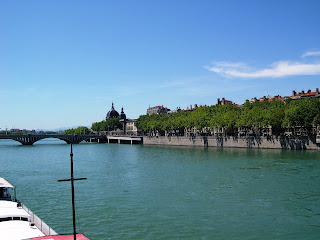Another of our experiences here is returning to school, Anna more than David. Anna goes to Conversational French classes for two hours on Tuesday, Wednesday, and Thursday. Both of us have been attending Découverte France classes for two hours every other Tuesday morning. This class has provided us with an introduction to everything from French geography, Régions and Départements, to population distribution. The class was taught by Andrée-Anne who insisted that each person research and present a report on one of France’s Régions, and that ALL speech during the class be in French. [Anna and I were allowed to jointly research and present a report.] Attendance at the class varied depending peoples’ schedules; the class consisted of 12 women of varying ages and nationalities, and 2 men – David and a Frenchman from Corsica. [GREAT ratio!]
For our final class June 21, Andrée-Anne hosted everyone at her lovely apartment in the 6th Arrondisement for a pot-luck lunch. Many French apartments are amazing – not large, but as in Andre-Anne’s case, including spectacular hidden amenities. Her apartment on what we would call the 2nd floor, included a full back yard of about 1000 square feet, complete with lawn, trees, flowers, and shrubs.
 |
| Distance Shot of Most of the Class Showing Yard |
The class took up a collection and we got a thank-you card and lovely potted fuchsia for our teacher, who at the beginning of the class had seemed a bit intimidating but who soon ‘loosened-up’ so that the class developed into an enjoyable experience for not just learning the subject, but also for meeting new friends and practicing our French language skills. We all took our responsibilities seriously and everyone presented thorough and informative reports on the numerous Régions of France. Many presentations included samples of the local wines and cheeses - the French know how to do education! We presented on Franche-Comté, the area where David’s ancestors came from.
 |
Most of the Class at Table Enjoying a Variety of Comestibles From Many Nations.
Another Shot of the Happy Group with Andree-Anne in the Foreground |
The lunch was a great success – beautiful weather, Andrée-Anne pronounced herself a great lover of fuchsias, all but one person appeared for the lunch, the food was great, the wine flowed, the conversation [en Français, bien sûr] was lively, and a great time was had by all. In addition, we had a selection of French popular music CDs playing – everyone from Charles Trenet to Edith Piaf, to Patricia Kaas. We even had a sing-along to a couple of them. [OK, I DID say the wine flowed!]














































